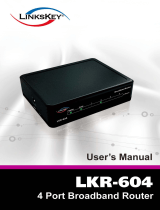
3 | Functions and Features
Broadband Modem and NAT Router
Connects multiple computers to a broadband (cable or DSL)
modem, and/or Ethernet router to access the Internet.
10/100 Mbps Ethernet Interface
Provides a 10/100 Base-TX interface to connect to a DSL or cable
modem for broadband Internet access.
Auto-sensing Ethernet Switch
Equipped with a 4-port auto-sensing Ethernet switch.
Printer sharing
Embedded a print server to allow all of the networked computers
to share one printer.
Built-in USB(parallel) host to connect to USB (parallel)printer for
printer sharing
WAN type supported
The router supports some WAN types, Static ,Dynamic, PPPOE
,PPTP , Dynamic IP with Road Runner.
Firewall
All unwanted packets from outside sources are blocked to protect
your intranet.
DHCP Server Supported
All networked computers can retrieve TCP/IP settings
automatically from this device.
Web-based Configuration
Configurable by any networked computer’s Web browser using
Netscape or Internet Explorer.
Network Filter Supported
The Packet Filter lets you control access to a network by analyzing
the incoming and outgoing packets; this lets you pass or halt
packets based on the IP address or the source and destination.
Universal Plug and Play (UPnP)
Supported
Enables devices such as PCs, routers and printers to be plugged
into a network and ensure automatic recognition.
Virtual Server Supported
Lets you make your Website, FTP site, and other services on your
LAN accessible to Internet users.
User Defined Application Sensing
Tunnel
Lets you define the attributes to support special applications that
require multiple connections like Internet gaming, video
conferencing, Internet telephony, and so on. This device can sense
the application type and opens a multi-port tunnel for it.
DMZ Host Supported
Enables a computer to be fully accessible to the Internet. This
function is used when the special application sensing tunnel
feature is insufficient to allow an application to function correctly.
SNMP Supported
SNMP (Simple Network Management Protocol) is a protocol that
lets users remotely manage a computer network by polling and
setting terminal values, and monitoring network events.
System Time Supported
Lets you synchronize system time with the network time server.
Virtual Computers Supported
The virtual computer lets you use the original NAT feature, which
lets you setup the one-to-one mapping of multiple global and local
IP addresses.
URL Blocking Supported
Lets you block hundreds of Website connections by simply
entering a keyword.
Schedule Rule
Lets you set a time schedule for different services.
9




















